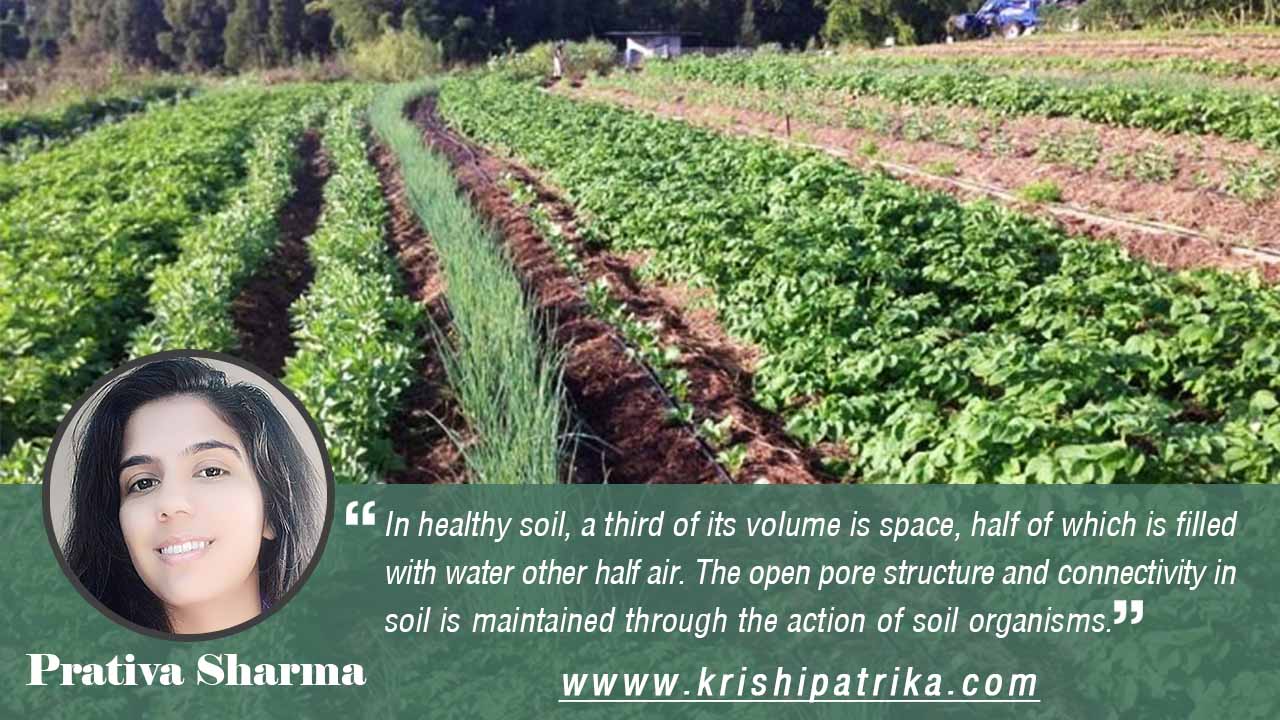
Soil, as defined by the Soil Science Society of America, is “the unconsolidated mineral or organic material on the immediate surface of the Earth that serves as a natural medium for the growth of land plants. The formation of soil, padeogenesis, is a very slow process. Soil is the greatest reservoir of biodiversity. A healthy soil is a living ecosystem in which dead organic matter forms the base of a food web consisting of microscopic and larger organisms. Generally, soil contains 40-45% inorganic matter, 5% organic matter, 25% water, and 25% air. Soil supplies nitrogen, phosphorus, potassium, calcium, magnesium, sulfur in relatively larger amounts, these are often called the macronutrients. In relatively small amounts, the soil supplies manganese, molybdenum, copper, chlorine, cobalt, Boron, Iron, Zinc, the so-called micronutrients.
Healthy soil for healthy plants:
In healthy soil, a third of its volume is space, half of which is filled with water other half air. The open pore structure and connectivity in soil is maintained through the action of soil organisms. In natural environment, plants form relationships with soil microbes to obtain water, nutrients and protection against some pathogens. In return plants provide food. Bacteria secrete gums and waxes that coat and glue the fabric of mineral particles together. Fungi spread thousands; immeasurable miles of filaments binding soil particles together into a complex matrix. Worms ingest soil and excrete castings that line and stabilize networks of channels from the surface extending deep underground, allowing air and water to move quickly. Most of the life in the soil is invisible, but is critically necessary for soil health. And healthy soil creates an environment in which beneficial insects thrive helping plants to be healthier too; fighting off pests and predators. The use of mineral fertilizers can make some of these relationships redundant, and their breakdown can lead to the loss of other benefits such as micronutrients and disease protection. The researchers found that fruits produced under organic farming generally contained more vitamins, more flavor compounds such as phenolic, and more antioxidants when compared with conventional farming.
Healthy soil and plant for healthy human being:
We define ourselves by our relationship to soil: the words “human” and “humanity” are linguistically rooted in “humus”- which is the fertile upper portion of the soil.
Healthy soils are part of the solution of some of our dilemmas- poverty, malnutrition and climate change-as they underpin processes that gives us food, energy and water. Soil help combat and adapt to climate change by playing a key role in the carbon cycle. Soil store and filter water, improving our resilience to floods and droughts. Soil is non-renewable resource. Its preservation is essential for food security and our sustainable future. Sustainable soil management could produce up to 58% more food. Healthy soils are the basis for healthy food production. 95% of our food is directly or indirectly produced on our soils. Fertile soil encourage plant growth by providing plant with nutrients, acting as a water holding tank, and serving as the substrate to which plants anchor their roots. The nutrient content of a plant’s tissues is directly related to the nutrient content of the soil and its ability to exchange nutrients and water with the plant’s roots. However, the practices of intensive agriculture, monoculture and deep tillage put soil health in risk by depleting the soil of nutrients, causing soil pollution, altering soil structure and water retention capacity, fostering soil erosion and decreasing soil biodiversity, which is the basis of soil biological activities (e.g. organic matter decomposition and nitrogen fixation) Agricultural production has witnessed a dramatic increase in the last three decades in the countries world over. This has been possible due to increase significantly agrochemicals as a vehicle for improved crop production technology and intensive farming practices. Due to the heavy use of agricultural technologies and heavy use of agrochemicals had several negative ecological consequences such as depletion of lands, decline in soil fertility, soil erosion, deterioration of the environment, health hazards, and poor sustainability of agricultural lands and degradation of bio-diversity. To achieve self-sufficiency in food, fiber and edible oil for efficient use of natural resources, solar radiation, precipitation and conservation agriculture is a management system that maintains a soil cover through surface retention of crop residues.
Techniques for healthy soil management:
Healthy soils are the foundation for profitable, productive, and environmentally sound agricultural system. Following are some of the techniques to maintain the good soil:
Reduce tillage:
Excessive tillage is harmful to soil health in various ways. Tillage disrupts soil aggregates, exposing particles of organic matter that had been physically protected within aggregates to microbial consumption. If additions of organic matter are not sufficient to counteract the losses from decomposition organic matter levels will decline over time, reducing soil health.
Conservation Tillage:
As compared to conventional tillage, conservation tillage systems reduce the rate of organic matter oxidation, balancing microbial activity and slowing down decomposition of root biomass. It maximizes the residue carbon input by slowing decay of residue left on the soil surface. Ridge-tillae, strip tillage, and no-tillage are conservation system use tillage practices that are defined by the percent of residue cover left on soil surface.
Cover Crops:
Cover crops are planted to provide ground cover or green manure between the cash crops. Cover crops contribute numerous benefits to soil health. They keep the soil covered during winter and other periods of time when crops are not growing, reducing the risk of erosion. The biomass produced by the cover crops is returned to soil, enhancing organic matter levels.
Crop Rotation:
Crop rotations involve a systematic farm plan, where the crop planted in one field on the farm changes every year or every season. More diverse crop rotations that include more crops in the rotation tend to have better soil quality. Longer crop rotations have been shown to improve the soil’s physical properties, decrease erosion, reduce nitrogen leaching potential, improve soil organic matter, and provide competitive crop yields.
Intercropping:
Intercropping principles increases diversity and interaction between plants, micro-organisms and other form of lives around resulting in a more stable crop-ecosystem and a more efficient use of the sunlight, water, space and nutrients. Furthermore, it cause fewer pest outbreaks, improved nutrient cycling and crop nutrient uptake, and increased water infiltration and moisture retention. It upgrades the soil as well as water quality.
Organic Amendments:
Manures and composts are applied as a basic carbon source to enhance overall and long-term soil health. Raw manure is high in nutrients, especially readily available nitrogen. However, the use of composted manure will contribute more to the organic matter content of the soil.
Limited use of chemical fertilizers:
Though chemical fertilizers increase crop production; their overuse decreases fertility, pollutes air and water, releases green- house gases, compacts the soil, reduces porosity, encourages pesticides, Farming system should be based on recycling of nutrients, organic fertilizers, compost manures rather than the chemical fertilizers. Chemical fertilizers decrease the quality of soil. Furthermore, it has harmful health hazards to living organisms in the food chain.
In a nutshell, soil is an essential ingredient for life but often goes unseen. Therefore to live a healthy life, healthy soil should be maintained. Inclusive soil management techniques should be adopted to promote soil health sustainably. Moreover, healthy soil is the basic foundation of development.









